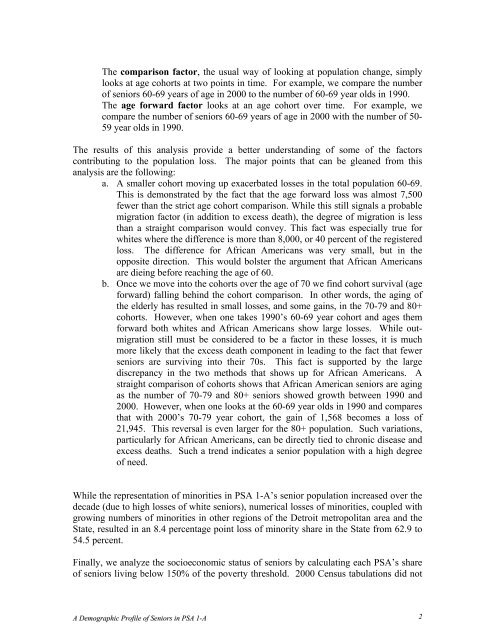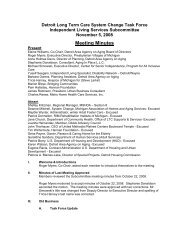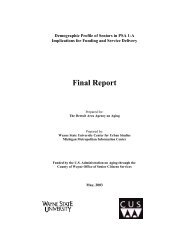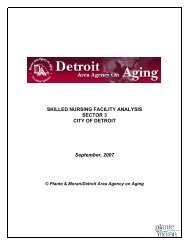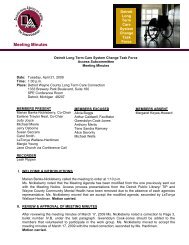Demographic Profile of Senior in Wayne County, Michigan
Demographic Profile of Senior in Wayne County, Michigan
Demographic Profile of Senior in Wayne County, Michigan
Create successful ePaper yourself
Turn your PDF publications into a flip-book with our unique Google optimized e-Paper software.
The comparison factor, the usual way <strong>of</strong> look<strong>in</strong>g at population change, simply<br />
looks at age cohorts at two po<strong>in</strong>ts <strong>in</strong> time. For example, we compare the number<br />
<strong>of</strong> seniors 60-69 years <strong>of</strong> age <strong>in</strong> 2000 to the number <strong>of</strong> 60-69 year olds <strong>in</strong> 1990.<br />
The age forward factor looks at an age cohort over time. For example, we<br />
compare the number <strong>of</strong> seniors 60-69 years <strong>of</strong> age <strong>in</strong> 2000 with the number <strong>of</strong> 50-<br />
59 year olds <strong>in</strong> 1990.<br />
The results <strong>of</strong> this analysis provide a better understand<strong>in</strong>g <strong>of</strong> some <strong>of</strong> the factors<br />
contribut<strong>in</strong>g to the population loss. The major po<strong>in</strong>ts that can be gleaned from this<br />
analysis are the follow<strong>in</strong>g:<br />
a. A smaller cohort mov<strong>in</strong>g up exacerbated losses <strong>in</strong> the total population 60-69.<br />
This is demonstrated by the fact that the age forward loss was almost 7,500<br />
fewer than the strict age cohort comparison. While this still signals a probable<br />
migration factor (<strong>in</strong> addition to excess death), the degree <strong>of</strong> migration is less<br />
than a straight comparison would convey. This fact was especially true for<br />
whites where the difference is more than 8,000, or 40 percent <strong>of</strong> the registered<br />
loss. The difference for African Americans was very small, but <strong>in</strong> the<br />
opposite direction. This would bolster the argument that African Americans<br />
are die<strong>in</strong>g before reach<strong>in</strong>g the age <strong>of</strong> 60.<br />
b. Once we move <strong>in</strong>to the cohorts over the age <strong>of</strong> 70 we f<strong>in</strong>d cohort survival (age<br />
forward) fall<strong>in</strong>g beh<strong>in</strong>d the cohort comparison. In other words, the ag<strong>in</strong>g <strong>of</strong><br />
the elderly has resulted <strong>in</strong> small losses, and some ga<strong>in</strong>s, <strong>in</strong> the 70-79 and 80+<br />
cohorts. However, when one takes 1990’s 60-69 year cohort and ages them<br />
forward both whites and African Americans show large losses. While outmigration<br />
still must be considered to be a factor <strong>in</strong> these losses, it is much<br />
more likely that the excess death component <strong>in</strong> lead<strong>in</strong>g to the fact that fewer<br />
seniors are surviv<strong>in</strong>g <strong>in</strong>to their 70s. This fact is supported by the large<br />
discrepancy <strong>in</strong> the two methods that shows up for African Americans. A<br />
straight comparison <strong>of</strong> cohorts shows that African American seniors are ag<strong>in</strong>g<br />
as the number <strong>of</strong> 70-79 and 80+ seniors showed growth between 1990 and<br />
2000. However, when one looks at the 60-69 year olds <strong>in</strong> 1990 and compares<br />
that with 2000’s 70-79 year cohort, the ga<strong>in</strong> <strong>of</strong> 1,568 becomes a loss <strong>of</strong><br />
21,945. This reversal is even larger for the 80+ population. Such variations,<br />
particularly for African Americans, can be directly tied to chronic disease and<br />
excess deaths. Such a trend <strong>in</strong>dicates a senior population with a high degree<br />
<strong>of</strong> need.<br />
While the representation <strong>of</strong> m<strong>in</strong>orities <strong>in</strong> PSA 1-A’s senior population <strong>in</strong>creased over the<br />
decade (due to high losses <strong>of</strong> white seniors), numerical losses <strong>of</strong> m<strong>in</strong>orities, coupled with<br />
grow<strong>in</strong>g numbers <strong>of</strong> m<strong>in</strong>orities <strong>in</strong> other regions <strong>of</strong> the Detroit metropolitan area and the<br />
State, resulted <strong>in</strong> an 8.4 percentage po<strong>in</strong>t loss <strong>of</strong> m<strong>in</strong>ority share <strong>in</strong> the State from 62.9 to<br />
54.5 percent.<br />
F<strong>in</strong>ally, we analyze the socioeconomic status <strong>of</strong> seniors by calculat<strong>in</strong>g each PSA’s share<br />
<strong>of</strong> seniors liv<strong>in</strong>g below 150% <strong>of</strong> the poverty threshold. 2000 Census tabulations did not<br />
A <strong>Demographic</strong> <strong>Pr<strong>of</strong>ile</strong> <strong>of</strong> <strong>Senior</strong>s <strong>in</strong> PSA 1-A 2


